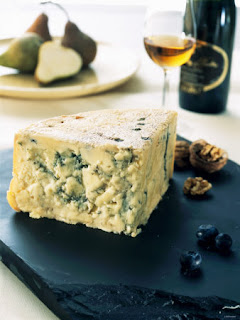It is perhaps helpful to understand the process that is used to make blue cheese in order to better appreciate the differences in the end product. Blue cheese is really a form of controlled spoilage. Early in the cheese making process, the cheese maker introduces the "Penicillium Roqueforti" spores into the milk. Once the cheese has been formed, long, thin needles are inserted into the cheese allowing air to enter the cheese through the tunnels that are created. The result is the growth of the familiar mould or veining. The mould breaks down the fats and proteins in the cheese and the longer that this process is allowed to occur, the more intense the flavour that develops and the smoother the texture of the cheese becomes. Blue cheese because of the tunnelling, ages from the inside out, the opposite of say for example, a cheddar which ages from the outside in.
As we would expect from this understanding of the cheese making process, Bénédictin has a more pronounced flavour and a smoother, creamier texture than its younger sibling, Ermite. In 2006, Bénédictin won the Canadian Grand Prix and is in stock at "C'est Cheese Please!" $4.85 per 100g. Enjoy this beautiful cheese with a soupcon of Cidre Glace, also from Québec. Cidre Glace is the fabulous Iced Cider from Pinnacle and is the perfect accompaniment to blue cheese especially a blue cheese from La Belle Province. I guarantee it will have you singing the blues, the blue cheese blues!
Bon Appétit!


